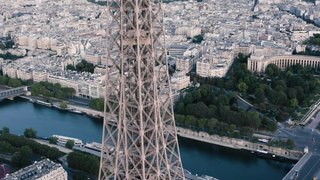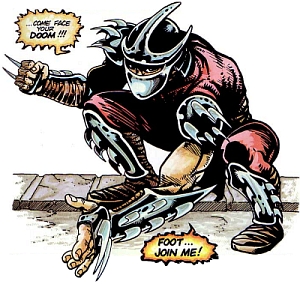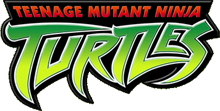
The Eiffel Tower is a wrought-iron lattice tower on the Champ de Mars in Paris, France. It is named after the engineer Gustave Eiffel, whose company designed and built the tower.

Red Tornado is a fictional superhero appearing in American comic books published by DC Comics.

Donatello, nicknamed Don or Donnie, is a fictional superhero and one of the four main characters of the Teenage Mutant Ninja Turtles comics and all related media. He is co-creator Peter Laird's favorite Turtle. In the Mirage comics, all four of the Turtles wear red masks. In the animated cartoons, he dons a purple mask. The creators gave all four turtles different mask colors, in order to tell them apart.

The Shredder is a fictional supervillain who appears in the Teenage Mutant Ninja Turtles comics and all of its related media. The Shredder was created by Kevin Eastman and Peter Laird and first appeared alongside the Turtles in Teenage Mutant Ninja Turtles #1 in May 1984. In every incarnation of the TMNT franchise, he is depicted as the leader of the criminal organization known as the Foot Clan, and serves as the archenemy of the Turtles and Splinter.

Cyborg is a fictional superhero appearing in American comic books published by DC Comics. The character was created by writer Marv Wolfman and artist George Pérez and first appears in an insert preview in DC Comics Presents #26. Originally known as a member of the Teen Titans, Cyborg was established as a founding member of the Justice League in DC's 2011 reboot of its comic book titles.

Paris Las Vegas is a casino hotel on the Las Vegas Strip in Paradise, Nevada. It is owned and operated by Caesars Entertainment and has a 95,263 square-foot casino with over 1,700 slot machines.

Krang is a fictional supervillain appearing in Teenage Mutant Ninja Turtles-related media, most frequently in the 1987 animated series and its associated merchandise, such as the Teenage Mutant Ninja Turtles Adventures comic book and most of the classic TMNT video games.
Skyscrapers are frequently featured in films for their impressive appearance and potent symbolism. They convey an impression of power – an old movie and TV cliché starts with the outside view of a skyscraper with a voice-over conversation, continuing inside the luxurious office of a tycoon or crime boss.

Teenage Mutant Ninja Turtles is an American animated television series produced by Murakami-Wolf-Swenson and the French company IDDH Groupe. It was the first television adaptation of the superhero team of the same name created by Kevin Eastman and Peter Laird.

Teenage Mutant Ninja Turtles is an American animated television series based on the superhero team of the same name. The series premiered on February 8, 2003, as part of the Fox's FoxBox programming block and ended on February 28, 2009.

After its unveiling in 1886, the Statue of Liberty, by Frédéric Auguste Bartholdi, quickly became iconic, and began to be featured on posters, postcards, pictures and books. The statue's likeness has also appeared in films, television programs, music videos, and video games, and has been used in logos, on postage stamps and coins, and in theatrical productions. Liberty Enlightening the World remains a popular local, national, and international political symbol of freedom.
Dimension X is a fictional alternate dimension or galaxy in the Teenage Mutant Ninja Turtles franchise. It appears in various forms in the 1987 series, the TMNT Adventures comics, the 2012 series, the IDW comics, and the UK Hero Turtles comics.

Bebop and Rocksteady are fictional warthog and rhinoceros henchmen appearing in publications featuring the Teenage Mutant Ninja Turtles and all related media. They follow the orders of villain Shredder, leader of the Foot Clan. Their names are both derived from genres of music: bebop is a style of jazz, while rocksteady is a Jamaican music style, a precursor to reggae.

Parademons are a fictional group of extraterrestrials appearing in American comic books published by DC Comics. They are monstrous shock troops of Apokolips used by Darkseid to maintain order on the planet.

Ōban Star-Racers is an English-language French-Japanese anime television series created by Savin Yeatman-Eiffel of Sav! The World Productions in association with multiple international companies. Originally produced as a short movie titled Molly Star Racer, a television series was developed in cooperation with Jetix Europe, with animation production by HAL Film Maker and Pumpkin 3D, a large portion of which was done in Tokyo, Japan. It aired in more than 100 countries including Japan. In the US, the series aired on the Jetix blocks on ABC Family and Toon Disney between June and December 2006.

The original World Trade Center, which featured the landmark Twin Towers, was a building complex in the Financial District in Lower Manhattan, New York City. 1 and 2 World Trade Center – the North and South Tower – stood at 417 meters and 415 meters with 110-stories respectively, becoming the tallest buildings in the world from 1971 to 1973. The North Tower, with its antenna included, was the tallest building in the world by pinnacle height until the towers were destroyed in the September 11 attacks in 2001. An iconic feature of the New York City skyline for nearly three decades, the World Trade Center has been featured in cartoons, comic books, computer games, video games, television, films, photographs, artwork, and music videos.

Magneto is the former rival and a member of the X-Men, and has been included in almost every media adaptation of the X-Men franchise, including film, television, computer and video games.
Because of its fame as a monument, Mount Rushmore in South Dakota has appeared frequently in works of fiction, and has been discussed or depicted in other popular works.

As a prominent American landmark, the Golden Gate Bridge has been used in a variety of media, often shown or mentioned where San Francisco, California is the setting of the story.

The Empire State Building is a 102-story skyscraper on Fifth Avenue between West 33rd and 34th Streets in Midtown, Manhattan, New York City. It has a roof height of 1,250 feet, and with its antenna included, it stands a total of 1,454 feet (443.2 m) tall. The Empire State Building stood as the world's tallest building for nearly 40 years, from its completion in early 1931 until the topping out of the original World Trade Center's North Tower in late 1970. It has been featured in numerous films, TV shows, songs, video games, books, photographs, and artwork.


















